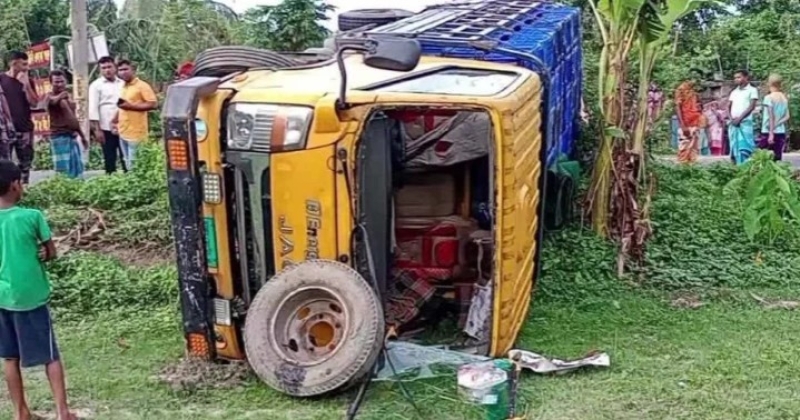- Dhaka’s Per Capita Income Rises to USD 5,163 |
- DSE turnover dips 18% despite weekly gains in key indices |
- 65 Nations Sign UN Treaty to Combat Cybercrime Globally |
- Dhaka’s air quality ‘unhealthy’ 5th worst in world Saturday |
- Dhaka’s air recorded unhealthy on Friday morning |
Highway horror in Cumilla region; 525 killed in 9 months

A goods-laden truck skids of the highway and leans on one side. UNB_11zon
Khairul Ahsan Manik, Cumilla, Oct 23 (UNB) - Every dawn in the Cumilla region brings the haunting prospect of yet another fatal road crash, with an average of three accidents a day claiming two lives and injuring five others, reflecting a grim landscape of disorder, decay and neglect on some of Bangladesh’s busiest highways.
In just nine months this year, 525 people have been killed in road accidents across the Cumilla region, nearly doubling last year’s tally.
The alarming rise has been recorded over 792 kilometres of major highways, including the Dhaka–Chattogram, Cumilla–Noakhali, Cumilla–Sylhet and Chattogram-Cox’s Bazar routes.
Superintendent of Police (Highway Region) Shahinur Alam Khan said 842 accidents occurred between January and September 2025, leaving 525 dead and 1,210 injured.
Of these, the Dhaka–Chattogram highway alone accounted for 465 accidents, with 284 deaths and 509 injuries, on the stretch between Daudkandi toll plaza in Cumilla and City Gate in Chattogram.
Compared to 2024, when 630 accidents claimed 522 lives and injured 784 others, both figures have already surged this year.
Officials fear 2025’s total may exceed all previous records if the trend continues.
Saiful Islam, Motor Vehicle Inspector at the Cumilla BRTA office, attributed more than 40% of these crashes to reckless speeding.
Despite enforcement drives, he said, the authorities have been unable to curb the menace due to a chronic shortage of manpower.
Journalist Abdullah Al Maruf blamed police inaction, especially following the August 5 movement last year, for the sharp increase in accidents, saying the Highway Police’s failure to enforce speed limits, seize unfit vehicles and take legal action against unlicensed drivers has worsened the situation.
He also criticised BRTA’s lack of visible efforts to ensure road safety. “The highways have been in disrepair for over a year. Potholes and broken surfaces not only damage vehicles but also cause deadly accidents,” Maruf said.
Kabir Ahmed, Vice-President of the Bangladesh Road Transport Owners Association, pointed to the overwhelming presence of illegal vehicles—at least 20 times more than the number of registered ones, as a key reason behind the chaos.
He said around 90% of highway accidents involve either unregistered vehicles or a mix of legal and illegal ones. “Unskilled and unlicensed drivers, three-wheelers on highways, illegal roadside markets and poor public awareness are compounding the risks.” .
According to him, of the 62 lakh registered motor vehicles in the country—46 lakh of which are motorcycles—only 29 lakh licences have been issued so far. This means about 33 lakh vehicles are being driven by unlicensed operators.
“It is also unclear whether BRTA maintains an accurate count of total vehicles, and there has never been a clear policy on how many vehicles the roads can actually support,” Kabir noted.
CCTV Cameras Offer Little Help
Nearly 1,500 CCTV cameras have been installed along the 250-kilometre Dhaka–Chattogram highway to monitor speed and enhance safety. Yet Highway Police say they cannot access data from many of these cameras.
SP Shahinur Alam said the systems have not yet been fully handed over to the police.
“We hope to gain full access soon,” he said, adding that functional cameras are currently monitored from a control room at Meghna Ghat.
Some cameras were also damaged during the August 5 protests, but efforts are underway to repair them, he added.
Three-Wheelers and Broken Roads Deepen the Crisis
Illegal three-wheelers remain a major hazard on highways. SP Shahinur admitted that completely banning them is difficult without expanding public transport.
“Many livelihoods depend on these vehicles. However, we are working to keep them out of key highway zones,” he said.
The Cumilla–Sylhet highway, particularly its 62-kilometre stretch, is among the worst in the region—riddled with potholes, narrow lanes and broken surfaces. Other regional roads under the Roads and Highways Department are in similar condition.
Abul Hasan, a driver for Sugandha Paribahan, said, “Not a single day goes by without an accident. The roads are narrow, broken and unsafe. Collisions between heavy and light vehicles are common. We’ve complained many times, but nothing changes.”
Sub-Assistant Engineer of Cumilla Roads and Highways Department, Adnan Ibn Alam, said around 150 kilometres of roads in the district were damaged by last year’s floods and this year’s heavy rains. “We hope to complete all repair work by December or January,” he added. - UNB

